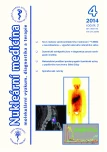Dynamic esophageal scintigraphy for detection of esophageal motility disorders – practical aspects
Authors:
Drahoslava Nováková; Vladimír Dedek
Authors‘ workplace:
Klinika nukleární medicíny, FN Ostrava
Published in:
NuklMed 2014;3:67-73
Category:
Review Article
Overview
Introduction:
Dynamic esophageal scintigraphy (DES) is a functional diagnostic test which analyses a transit of a bolus of a radiopharmaceutical (RP) through the esophagus to the stomach. Evaluation of esophageal motility is useful in a series of pathologies in adults as well as children after an organic disease is excluded. The most frequent indication is a suspicion to the peristalsis disorder including malfunction of the lower esophageal sphincter in esophageal reflux disease (ERD), less frequent indication is evaluation of patients with autoimmune systemic diseases, diabetics etc.
Methods:
3 to 6 hours npo, prokinetics withdrawal for 48 hours, supine position, detector above the thorax. Technologist trains swallowing of appropriate volume of RP – adults 10 ml, children 5 ml. The patient then swallows the bolus of a RP (20 to 50 MBq of 99mTc MAA) and the dynamic study begins: 1st group – 240 frames 120 ms each; 2nd group – 120 frames 15 sec each. We draw regions of interest (ROI) above individual thirds of the esophagus and above the stomach. We evaluate mean transit time (MTT), antiperistalsis or retention of RP in the esophagus from the first group after dynamic curves are created. Gastroesophageal reflux (GER) presence is evaluated form the second group.
Results:
We present examples of antiperistalsis, prolonged MTT, retention and GER in ERD, bronchial asthma, chronic cough, sclerodermia and achalasia.
Conclusion:
DES is a simple, functional, non-invasive diagnostic test with a low radiation, which has a high sensitivity for the detection of esophageal motility disorder. It gives additional functional information as the organic disease is excluded. It is useful also in children. It can also be used for better control of the treatment.
Key words:
dynamic esophageal scintigraphy, mean transit time, antiperistalsis, gastroesophageal reflux, esophageal reflux disease
Sources
1. Lukáš M. Refluxní choroba jícnu, symptomatologie, diagnostika a léčba. Lékařské Listy 2005;28:3–6
2. Dolina J, Kroupa R, Prokešová J a kol. Racionální indikace 24hodinové pH-metrie a multikanálové impedance jícnu. Čes a slov gastroenterol a hepatol 2007;61(Suppl II):29
3. Válek, V.: Moderní diagnostické metody: Válek, V., Prokeš, B.: I. díl. Kontrastní vyšetření trávicí trubice, 1996, IDVPZ v Brně, s.76
4. Kazem I. A new scintigraphic technique for the study of the esophagus. A J Roentgenol 1972;115:681–688
5. Malmud LS, Fisher RS. Radionuclide studies of esophageal transit and gastroesophageal reflux. Semin Nucl Med 1982;2:104–115
6. Fischer RS, Malmud LS, Roberts GS et al. Gastroesophageal (GE) scintiscanning to detect and quantitate GE reflux. Gastroenterology 1976;70:301–308
7. Ullmann V, Slanina A. OSTNUCLINE – komplexní vyhodnocení scintigrafických studií, KNM, FN Ostrava. 2000
8. Prášek J. Dynamická scintigrafie jícnu u nemocných s refluxní chorobou jícnu. Čes a Slov Gastroenterologie 1999; 53:145–149
9. Klein HA. The effect of projection in esophageal transit scintigraphy. Clin Nucl Med 1990;3:157–162
10. Blackwell JN, Hannan WJ, Adam RD et al. Radionuclide transit studies in the detection of esophageal dysmotility. Gut 1983;24:421–426
11. Fisher RS, Malmud LS, Applegate G et al. Effect of bolus composition on esophageal transit: concise communication. J Nucl Med 1982;23:878–882
12. Cunningham KM, Horowitz M, Riddell PS et al. Relations among autonomic nerve dysfunction, oesophageal motility, and gastric emptying in gastro-oesophageal reflux disease. Gut 1991;32:1436–1440
13. Hušák V, Heřman V, Závoda P a kol. Radiační zátěž pacientů ze zobrazovacích metod - doplnění publikace „Indikační kritéria pro zobrazovací metody“. Česká radiologie 2004;58:258–261
14. Prášek J, Dolina J, Dítě P. Dynamická scintigrafie jícnu u nemocných s achalázií. Česká Radiologie 2000;54:258-261
15. Dedek V, Ullmann V. Dynamická scintigrafie jícnu v diagnostice refluxní choroby jícnu. Gastroenterologie a hepatologie 2011;65:15–21
16. Akesson A, Gustafson T, Wollheim F et al. Esophageal dysfunction and radionuclide transit in progressive systemic sclerosis. Scand J Rheumatol 1987;16:291–299
17. Kjellén G, Svedberg JB, Tibbling L et al. Computerized scintigraphy of oesophageal bolus transit in asthmatics. Int J of Nucl and Biol 1981;8:153–158
18. Dedek V, Ullmann V, Kosek V. Dynamická scintigrafie jícnu v diagnostice refluxní choroby jícnu u nemocných s bronchiálním astmatem a chronickým kašlem. Studia pneumologica et phthiseologica 2010;70:138–145
19. Kjellén G, Tibbling L, Wranne B. Effect of conservative treatment of oesophageal dysfunction on bronchial asthma. Eur J Respir Dis 1981;62:190–197
Labels
Nuclear medicine Radiodiagnostics RadiotherapyArticle was published in
Nuclear Medicine

2014 Issue 4
Most read in this issue
- Dynamic esophageal scintigraphy for detection of esophageal motility disorders – practical aspects
- Metastasis into parapharyngeal lymph node in papilary thyroid cancer
- New method for semiquantitative evaluation of 123I-MIBG in neuroblastoma – calculation of total retention score
